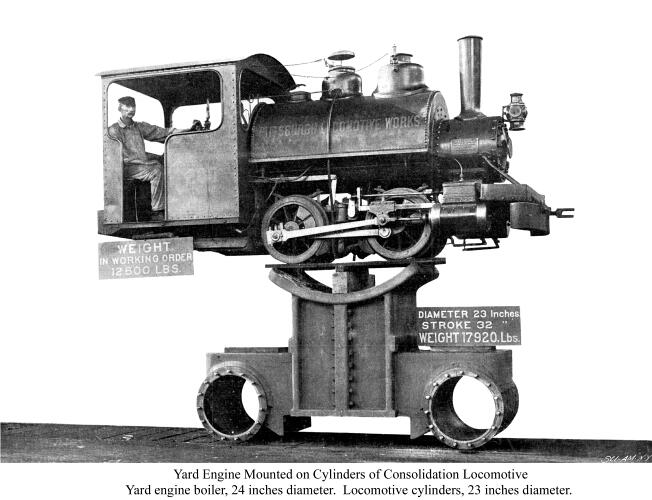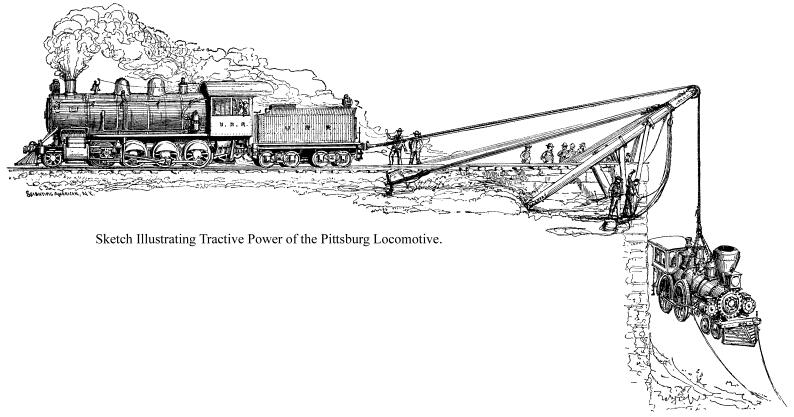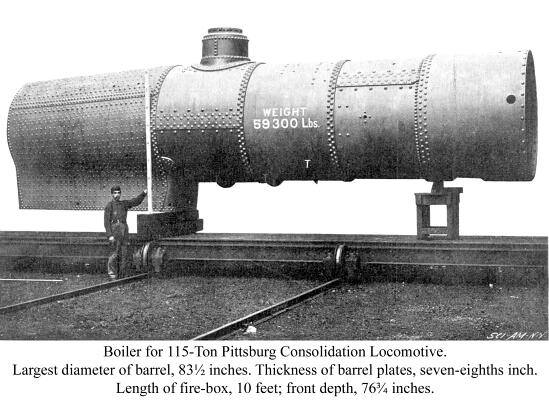ANOTHER MAMMOTH LOCOMOTIVE.
Scientific American—December 3,
1898

The locomotive which we illustrate this week is unquestionably
the most powerful ever constructed. As we have shown elsewhere,
the continually increasing size of American engines is due to
the desire to secure the most economical results in operation.
As between the policy of hauling a heavy train with a single engine
or two light trains with light engines, there is, in the former
case, a saving of the expense of a complete train crew. Further
advantages, at least on tracks where the traffic is heavy, result
from the reduction of the number of separate trains in operation.

The two locomotives of the type shown have recently been built
by the Pittsburg Locomotive and Car Works for the Union Railroad
Company, Pittsburg. They are at work on a short stretch of line
between Munhall and North Bessemer, Pa., which forms part of the
Carnegie system and connects the Duquesne Furnaces, Homestead
Steel Works and the Edgar Thomson Steel Works. Four miles of the
line are built on a grade of 70 feet to the mile and another stretch
of the road (about 2,000 feet) is built on the unusually heavy
grade of 2.7 per cent.
We are informed by Mr. D. A. Wightman, the general manager
of the Pittsburg Locomotive and Car Works, to whom we are indebted
for the photographs from which our engravings were prepared, that,
owing to the great amount of wet weather since these locomotives
went into service, the company have been unable to secure any
reliable data of their performance in actual service on the various
grades of the road.
The estimated tractive force, however, is 53,280 pounds and
the estimated hauling capacity on a practically level track is
about 6,650 tons. Now, just what these figures mean can perhaps
be best understood by expressing them in other terms. The accompanying
sketch, which is, of course, purely imaginary, shows what an engine
with a drawbar pull of 26½ tons could accomplish in the
way of lifting dead weight. The locomotive slung in chains represents
a passenger engine of the average size used in this country thirty
to forty years ago. If a cable were passed from the slings over
a pulley and carried to the drawhead of the tender of one of these
Pittsburg consolidations, she would be able to raise the smaller
locomotive by direct pull without the use of any kind of purchase.

The hauling capacity on a level of 6,650 tons represents a
train of 166 box cars loaded with wheat. The total length of such
a train would be 5,700 feet, or considerably over a mile, and
the wheat would represent, at an average of 15 bushels to the
acre, the product of 9,000 acres, or over 14 square miles of land.
And this enormous load could be taken over the road, or rather
the level portions of it, at a comfortable speed of 10 miles an
hour.
He would have seemed a bold prophet to our forefathers who
would have dared to foretell that at the close of this century
we should have steam horses that could cart away the products
of 14 square miles of the countryside at a load, and do it at
a gait faster than that of the local mail coach.
The very remarkable photograph which is reproduced on the front
page serves excellently well the purpose for which it was taken,
namely, to give an impressive idea of the great size of the parts
of the locomotive. The little engine was lifted to its perch by
the shop crane. It is standing on the cylinder casting, which
weighs 8¾ tons, as against a weight of 6¼ tons for
the yard engine. The other particulars of the yard engine are:
Cylinders, 6 by 10 inches; gage, 24 inches; diameter of boiler,
24 inches; driving wheels, 26½ inches; tractive force,
1,883 pounds.
 It will thus
be seen that the cylinders of the big engine, which are 23 inches
in diameter, are only 1 inch less than the diameter of the yard
engine boiler. It will thus
be seen that the cylinders of the big engine, which are 23 inches
in diameter, are only 1 inch less than the diameter of the yard
engine boiler.
The cylinders of the consolidation are of the half-saddle type,
made heavy, and have great depth longitudinally. A steel plate
1-and-three-eighths inches thick, and of the same width as the
bottom of the saddle, extends across and is bolted to the lower
frames, and to this plate, as well as to the frames, the cylinders
are securely fastened. Heavy bolts passing through the top frame
bars at the front and back of the saddle form additional transverse
ties, and relieve the saddle casting from all tensile strains.
The longitudinal strains usually transmitted to cylinders through
frames are largely absorbed by the use of a casting extended from
the buffer beam well up to the saddle, and securely bolted to
the top and bottom frames. This casting also acts as a guide for
the bolster pin of the truck. The above method of relieving cylinders
of longitudinal stress was introduced by the Pittsburg Locomotive
Works nearly two years ago and has proved in practical use on
a large number of locomotives to be of great value in reducing
the breakage of saddle castings. The frames are 4½ inches
wide. They were cut front rolled steel slabs made by the Carnegie
Steel Company and weigh 8½ tons per pair, finished.
In the accompanying table we give a comparison of some of the
most notable of the recent big freight locomotives, from which
it will be seen that the latest is considerably the largest of
the big fellows. They are arranged in the order of their construction.

The tender is of the standard type and weighs, loaded, 52 tons,
so that the weight of the engine and tender in working order is
167 tons. The total length over all of engine and tender is 63
feet 3½ inches. The center of the boiler is 9 feet 3-and-three-eighths
inches above the rails, the top of the boiler is 13 feet and the
smokestack 15½ feet above the rails. The driving axle journals
are 9 by 12 inches, and the main crank-pin is 7 by 7 inches. The
steam ports are 1-and-three-eighths inches wide by 20 inches long,
while the exhaust ports are 3¼ inches by 20 inches. The
tender has a capacity of 5,000 gallons of water and 10 tons of
coal.
Stories Page | Contents Page
|







